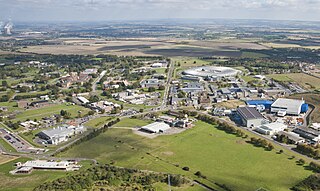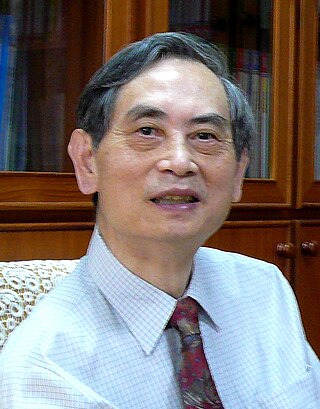
The United States Department of Energy National Laboratories and Technology Centers is a system of laboratories overseen by the United States Department of Energy (DOE) for scientific and technological research. The primary mission of the DOE national laboratories is to conduct research and development (R&D) addressing national priorities: energy and climate, the environment, national security, and health. Sixteen of the seventeen DOE national laboratories are federally funded research and development centers administered, managed, operated and staffed by private-sector organizations under management and operating (M&O) contracts with the DOE.

Spallation is a process in which fragments of material (spall) are ejected from a body due to impact or stress. In the context of impact mechanics it describes ejection of material from a target during impact by a projectile. In planetary physics, spallation describes meteoritic impacts on a planetary surface and the effects of stellar winds and cosmic rays on planetary atmospheres and surfaces. In the context of mining or geology, spallation can refer to pieces of rock breaking off a rock face due to the internal stresses in the rock; it commonly occurs on mine shaft walls. In the context of anthropology, spallation is a process used to make stone tools such as arrowheads by knapping. In nuclear physics, spallation is the process in which a heavy nucleus emits numerous nucleons as a result of being hit by a high-energy particle, thus greatly reducing its atomic weight. In industrial processes and bioprocessing the loss of tubing material due to the repeated flexing of the tubing within a peristaltic pump is termed spallation.

The Rutherford Appleton Laboratory (RAL) is one of the national scientific research laboratories in the UK operated by the Science and Technology Facilities Council (STFC). It began as the Rutherford High Energy Laboratory, merged with the Atlas Computer Laboratory in 1975 to create the Rutherford Lab; then in 1979 with the Appleton Laboratory to form the current laboratory.

The Spallation Neutron Source (SNS) is an accelerator-based neutron source facility in the U.S. that provides the most intense pulsed neutron beams in the world for scientific research and industrial development. Each year, this facility hosts hundreds of researchers from universities, national laboratories, and industry, who conduct basic and applied research and technology development using neutrons. SNS is part of Oak Ridge National Laboratory, which is managed by UT-Battelle for the United States Department of Energy (DOE). SNS is a DOE Office of Science user facility, and it is open to scientists and researchers from all over the world.
Intense Pulsed Neutron Source (IPNS) was a scientific user facility at Argonne National Laboratory for neutron scattering research. The IPNS was the world's first pulsed neutron source open to external users and started operations in 1981. The facility ceased operation in January, 2008 after the omnibus spending bill forced Basic Energy Sciences (BES) to cease IPNS operations.

The European Spallation Source ERIC (ESS) is a multi-disciplinary research facility currently under construction. The ESS is currently under construction in Lund, Sweden, while its Data Management and Software Centre (DMSC) is situated in Copenhagen, Denmark. The 13 European member countries are partners in the construction and operation of ESS. ESS is scheduled to begin its scientific user program in 2023, with the construction phase set to be completed by 2025. ESS will enable scientists to observe and understand basic atomic structures and forces, which is not achievable with other neutron sources in terms of lengths and time scales. The research facility is located close to the Max IV Laboratory, which conducts synchotron radiation research. The construction of the facility began in the summer of 2014 and the first science results are planned for 2023.
J-PARC is a high intensity proton accelerator facility. It is a joint project between KEK and JAEA and is located at the Tokai campus of JAEA. J-PARC aims for the frontier in materials and life sciences, and nuclear and particle physics. J-PARC uses high intensity proton beams to create high intensity secondary beams of neutrons, hadrons, and neutrinos.

A neutron research facility is most commonly a big laboratory operating a large-scale neutron source that provides thermal neutrons to a suite of research instruments. The neutron source usually is a research reactor or a spallation source. In some cases, a smaller facility will provide high energy neutrons using existing neutron generator technologies.

The Los Alamos Neutron Science Center (LANSCE), formerly known as the Los Alamos Meson Physics Facility (LAMPF), is one of the world's most powerful linear accelerators. It is located in Los Alamos National Laboratory in New Mexico in Technical Area 53. It was the most powerful linear accelerator in the world when it was opened in June 1972. The technology used in the accelerator was developed under the direction of nuclear physicist Louis Rosen. The facility is capable of accelerating protons up to 800 MeV. Multiple beamlines allow for a variety of experiments to be run at once, and the facility is used for many types of research in materials testing and neutron science. It is also used for medical radioisotope production.
A Fixed-Field alternating gradient Accelerator is a circular particle accelerator concept that can be characterized by its time-independent magnetic fields and the use of alternating gradient strong focusing.
Alvin William Trivelpiece was an American physicist whose varied career included positions as director of the Office of Energy Research of the U.S. Department of Energy (DOE), executive officer of the American Association for the Advancement of Science (AAAS), and director of Oak Ridge National Laboratory (ORNL). He was also a professor of physics and a corporate executive. Trivelpiece's research focused on plasma physics, controlled thermonuclear research, and particle accelerators. He received several patents for accelerators and microwave devices. He died in Rancho Santa Margarita, California in August 2022 at the age of 91.

The China Spallation Neutron Source is an accelerator-based neutron source, operated by the Institute of High Energy Physics, under construction at Dongguan in Guangdong province - the first major scientific facility in south China. The project was approved by Chinese central government in 2005. Construction began 20 October 2011, with commissioning planned for 2016, and operation in 2018.

Sow-Hsin Chen, was a Hoklo Taiwanese physicist and Professor Emeritus at Massachusetts Institute of Technology (MIT). He was a recognized pioneer in the research of the dynamic properties of supercooled and interfacial water with the use of neutron scattering techniques. As an educator, he was recognized for his training of young scientists in the use of those same techniques. Regarding hydrogen storage, his research focused on the use of activated carbon to allow hydrogen to be stored at room temperature.
The Zero Gradient Synchrotron (ZGS), was a weak focusing 12.5 GeV proton accelerator that operated at the Argonne National Laboratory in Illinois from 1964 to 1979.
Ronald M. Gilgenbach is the Chair of the Nuclear Engineering and Radiological Sciences Department at the University of Michigan. His career is in the field of Plasma Physics, including some of the earliest tokamak plasma research in the United States. Gilgenbach has been at the University of Michigan since 1980 and has held his Chair position since 2010. He is also the lead faculty of the Plasma, Pulsed Power, and Microwave Laboratory at the University of Michigan.
John Arrington is a nuclear physicist and group leader of Medium-Energy Physics, Physics Division, at the Argonne National Laboratory. He is known for his leading role in a number of important nuclear physics and medium-energy/high-energy experiments at the Argonne and Jefferson National Laboratory Accelerator Thomas Jefferson National Accelerator Facility facilities. He is perhaps one of the most active and most cited young nuclear physicists in the world, with more than 8000 citations to his work and an H-index of 51.
Science tourism is a travel topic grouping scientific attractions. It covers interests in visiting and exploring scientific landmarks, including museums, laboratories, observatories and universities. It also includes visits to see events of scientific interest, such as solar eclipses.
Kawtar Hafidi is a Moroccan-American experimental nuclear physicist and the Associate Laboratory Director for Physical Sciences and Engineering at Argonne National Laboratory. She researches nucleon and nuclear structure using major accelerator facilities, e.g., Jefferson Lab, DESY, and Fermilab. She is also an advocate for diversity and almost became a professional soccer player when she was 16.
The National User Facilities are a set of large-scale scientific facilities maintained by the U.S. Department of Energy, Office of Science, whose roles are to provide the scientific community with world-leading scientific instruments to enable research. These facilities are generally free to use, and are open to scientists from all over the world, usually through the submission and evaluation of research proposals.
Yanglai Cho was a Korean physicist.









